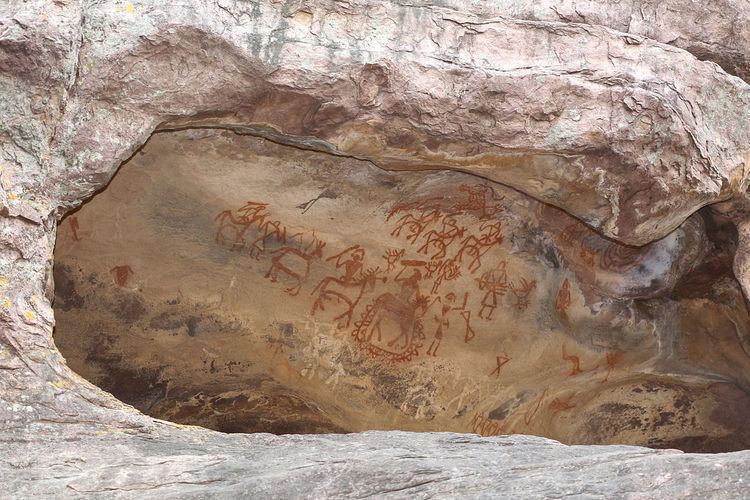Criteria (iii)(v) UNESCO region South Asia | Type Cultural Reference 925 UNESCO World Heritage Site inscription 2003 | |
 | ||
Hours Open today · 7AM–6PMMonday7AM–6PMTuesday7AM–6PMWednesday7AM–6PMThursday7AM–6PMFriday7AM–6PMSaturday7AM–6PMSunday(Holi)7AM–6PMHours might differ Similar Udayagiri Caves, Rani ki vav, Bharhut | ||
Bhimbetka rock shelters a unesco world heritage
The Bhimbetka rock shelters are an archaeological site of the Paleolithic, exhibiting the earliest traces of human life on the Indian Subcontinent, and thus the beginning of the Indian Stone Age. It is located in the Raisen District in the Indian state of Madhya Pradesh, near Abdullaganj town and inside the Ratapani Wildlife Sanctuary. At least some of the shelters were inhabited by Homo erectus over 100,000 years ago. Some of the Stone Age rock paintings found among the Bhimbetka rock shelters are some 30,000 years old. The caves also deliver early evidence of dance. They were declared a World Heritage Site in 2003.
Contents
- Bhimbetka rock shelters a unesco world heritage
- India bhimbetka rock shelters part 31
- Location
- Discovery
- Rock art and paintings
- Eroded paintings
- References
The name Bhimbetka (भीमबेटका) is associated with Bhima, a hero-deity of the epic Mahabharata. The word Bhimbetka is said to derive from Bhimbaithka (भीमबैठका), meaning "sitting place of Bhima".
India bhimbetka rock shelters part 31
Location
The Rock Shelters of Bhimbetaka (or Bhim Baithaka) lies 9 km from Obedullaganj city in the Raisen District of Madhya Pradesh and 45 kilometers south of Bhopal at the southern edge of the Vindhya hills. South of these rock shelters are successive ranges of the Satpura hills.
The entire area is covered by thick vegetation, has abundant natural resources in its perennial water supplies, natural shelters, rich forest flora and fauna and bears a striking resemblance to similar rock art sites such as Kakadu National Park in Australia, the cave paintings of the Bushmen in Kalahari Desert and the Upper Paleolithic Lascaux cave paintings in France.
Discovery
As reported in the UNESCO citation declaring the Rock Shelters of Bhimbetka a World Heritage Site, Bhimbetka was first mentioned in Indian archaeological records in 1888 as a Buddhist site, based on information gathered from local adivasis. Later V. S. Wakankar, while travelling by train to Bhopal, saw some rock formations similar to those he had seen in Spain and France. He visited the area with a team of archaeologists and discovered several prehistoric rock shelters in 1957.
Since then more than 750 such shelters have been identified, of which 243 are in the Bhimbetka group and 178 in the Lakha Juar group. Archaeological studies revealed a continuous sequence of Stone Age cultures (from the late Acheulian to the late Mesolithic), as well as the world’s oldest stone walls and floors.
Barkheda has been identified as the source of the raw materials used in some of the monoliths discovered at Bhimbetka.
Rock art and paintings
The rock shelters and caves of Bhimbetka have a large number of paintings. The oldest paintings are considered to be 30,000 years old, but some of the geometric figures date to as recently as the medieval period. The colors used are vegetable colors which have endured through time because the drawings were generally made deep inside a niche or on inner walls. The drawings and paintings can be classified under seven different periods.
Period I - (Upper Paleolithic): These are linear representations, in green and dark red, of huge figures of animals such as bison, tigers and rhinoceroses.
Period II - (Mesolithic): Comparatively small in size the stylised figures in this group show linear decorations on the body. In addition to animals there are human figures and hunting scenes, giving a clear picture of the weapons they used: barbed spears, pointed sticks, bows and arrows. The depiction of communal dances, birds, musical instruments, mothers and children, pregnant women, men carrying dead animals, drinking and burials appear in rhythmic movement.
Period III - (Chalcolithic) Similar to the paintings of the Chalcolithic, these drawings reveal that during this period the cave dwellers of this area were in contact with the agricultural communities of the Malwa plains, exchanging goods with them.
Period IV & V - (Early historic): The figures of this group have a schematic and decorative style and are painted mainly in red, white and yellow. The association is of riders, depiction of religious symbols, tunic-like dresses and the existence of scripts of different periods. The religious beliefs are represented by figures of yakshas, tree gods and magical sky chariots.
Period VI & VII - (Medieval) : These paintings are geometric linear and more schematic, but they show degeneration and crudeness in their artistic style. The colors used by the cave dwellers were prepared by combining manganese, hematite and wooden coal.
One rock, popularly referred to as “Zoo Rock”, depicts elephants, Barasingha, bison and deer. Paintings on another rock show a peacock, a snake, a deer and the sun. On another rock, two elephants with tusks are painted. Hunting scenes with hunters carrying bows, arrows, swords and shields also find their place in the community of these pre-historic paintings. In one of the caves, a bison is shown in pursuit of a hunter while his two companions appear to stand helplessly nearby; in another, some horsemen are seen, along with archers.
In one painting, a large wild boar is seen (see thumbnail picture). It is not known whether such large boars existed that time (note that, according to the skeletons found, those humans were about 7 feet tall) or the humans drew it with enlarged scale.
Eroded paintings
In one of the desolate rock shelters, the painting of a man holding a trident-like staff and dancing has been named “Nataraj” by Dr. Wakankar. Pluvial erosion marks most of the paintings in this shelter and the Archaeological Survey of India uses chemicals and wax to preserve them.
